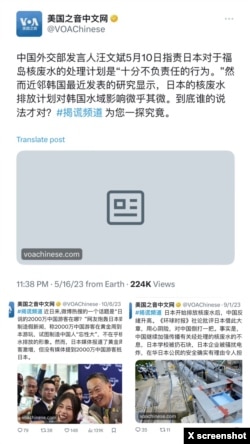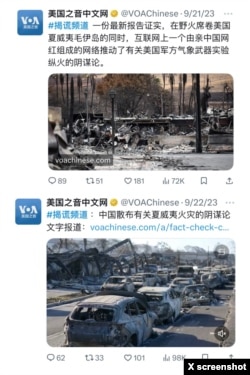In the last year, Beijing has stepped up efforts in sowing disinformation to discredit the United States at home and abroad.
Other hot-button targets included Taiwan, the South China Sea, Xinjiang, the Ukraine war, and the Israeli-Hamas conflict.
China has mimicked Russian disinformation tactics and narratives, especially in information campaigns to support the regimes in Syria and Iran and discredit Ukraine’s struggle against Russian aggression.
Beijing used three major channels to spread propaganda and disinformation, including top government officials, state-backed media outlets, and government-linked influencers on social media platforms. On two platforms, X and YouTube, China has deployed considerable resources to counter criticism and boost its image abroad.
“Beijing’s information manipulation spans the use of propaganda, disinformation, and censorship,” the U.S. State Department said in a special report published in September that examined China’s propaganda efforts.
Below are a few examples of the Chinese propaganda and disinformation that Polygraph.info unveiled and debunked in 2023.
Government officials
Polygraph closely monitors the disinformation narratives pushed forward by Chinese government officials, particularly the Ministry of Foreign Affairs through its daily briefings.
One of Beijing’s major disinformation campaigns of 2023 involved China’s fabrication of a global environmental catastrophe from Japan’s discharge of purified nuclear wastewater from the Fukushima nuclear plant into the Pacific Ocean. This campaign was designed to target both domestic and foreign audiences.
Spokespeople from China’s Ministry of Foreign Affairs routinely described Japan as “extremely irresponsible” and accused it of “selfishly putting the world at risk.” Once the discharge started, the foreign ministry called Japan “a saboteur of the ecological system and polluter of the global marine environment.”
Polygraph vetted these claims as misleading because the PRC government officials have ignored multiple facts that are vital to the truth about the Fukushima wastewater. First, the Chinese propaganda did not mention the rigorous process Japan used to purify the water before dumping it into the ocean, which included running the wastewater through a chain of advanced filters. Beijing intentionally left out that the International Atomic Energy Agency (IAEA) had been providing real-time data to monitor the Fukushima water’s level of radioactivity. China also avoided mentioning that most Pacific countries, including South Korea and Micronesia, who used to be fierce critics of the plan, eventually gave Japan the green light.
Polygraph.info’s fact checks on this topic received a combination of 395,000 views on X (formerly Twitter), where netizens questioned whether China’s actions on the matter were more about politics than science.
State-backed media
Chinese state media and state-backed news outlets are dominated by publications that promote Beijing’s narratives on world issues. One of the keys of this narrative is to portray the United States as the world’s super-villain and a nation unfriendly to the Chinese people.
Taiwan, the self-ruled island Beijing claims as its own province, is another target on the front line of China’s hybrid warfare. China has been spinning a web of influence campaigns to win over Taiwan’s public opinion in recent years, particularly at a time when the U.S. is strengthening its commitment to help the island defend its sovereignty.
Partly because of these campaigns, Taiwanese trust in the U.S. dropped 10% between 2021 and 2022, and this year the number stood at 33.9%, according to a new poll conducted in November. Thus, fact-checking China’s disinformation targeting Taiwan is vital for understanding and exposing Beijing’s propaganda goals.
One of the persistent narratives is aimed at discrediting U.S. aid to Taiwan by attacking its quality and questioning its intentions.
Global Times, the English language tabloid arm of the People’s Daily that provides news and commentaries on international affairs and China’s foreign relations from a nationalist perspective, is a vital organ to the Chinese Communist Party’s foreign propaganda.
In August, GT published an editorial questioning the intention of U.S. arms sales to Taiwan and claiming they only benefited the United States’ military-industrial complex. The U.S. was sending to Taiwan “outdated yet overpriced weapons,” GT wrote.
Polygraph vetted that claim as false after talking to the U.S. military experts, as well as the former chief of the Taiwanese military, Lee His-Min, who introduced the current porcupine strategy for the island to counter China’s military threat.
Experts pointed out that the U.S. has sent top-of-the-line equipment to Taiwan for many years. The Foreign Military Sales (FMS) system, through which Taiwan obtains most of its U.S.-made weapons, treats all foreign customers equally. That includes the pricing.
Polygraph.info fact check prompted a robust engagement among the Mandarin-speaking audiences and generated more than 200,000 views on Twitter.
Social media
Meta, the company that owns Facebook and Instagram, said in November it has taken down five China-based networks of fake accounts targeting foreign audiences this year, each involving thousands of misleading accounts focused on promoting Chinese interests and discrediting Western countries, particularly the United States.
Beijing has also been employing a network of multilingual social media influencers to push pro-Chinese Communist Party narratives.
Polygraph has written numerous fact-checks on China’s social media disinformation campaigns.
For example, after wildfires swept across Hawaii’s Maui in August killing at least 97 people, pro-China influencers shared false claims saying the United States military started the fires in a weather weapon experiment.
This conspiracy theory spread from China’s internet platforms Baidu and Weibo to Western social media such as X and YouTube, with a network of accounts posting identical messages in 15 languages in addition to Chinese. Polygraph’s fact-check and video that exposed the propaganda network and debunked this conspiracy theory received 171,000 views on X.
Earlier in September, Polygraph.info identified a propaganda campaign involving pro-Beijing influencers on X, claiming the U.S. blockade against China’s tech giant Huawei had failed.
In 2022, pro-China actors used X to discredit Safeguard Defenders, a non-governmental organization that published a report about China’s overseas police stations.
Another major tactic China employs to discredit the U.S. involves using political cartoons and generative artificial intelligence. Polygraph.info identified and exposed state media-affiliated accounts that used this visual tool to transmit the Chinese Communist Party’s foreign propaganda and boost anti-U.S. disinformation.
The U.S. State Department said in a September 2023 report, that as of 2021, almost 100 influencers were known to be disseminating official Chinese messaging in at least two dozen languages on multiple social media platforms to a combined audience of more than 11 million people.









